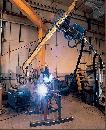 |
| |||
At a time when specifications and customer demands grow tighter, selecting the right wire feeder can make a critical difference in productivity and profitability. Fortunately, new enhancements in wire feeder technology provide features that help fabricators and manufacturers overcome challenges and allow operators to do their best work.
When welding occurs where the power source is in a dedicated location, the best choice is a benchtop-style or boom-mounted style of wire feeder. These give the greatest flexibility regarding wire type, spool size, the number of drive rolls and a wide array of advanced control options. Note that this story focuses on feeders for hard and cored wires—aluminum is a subject all its own.
Basic Benchtop Feeder
A basic benchtop wire feeder, such as Miller’s 22A, features a single wire reel assembly, two gear-driven drive rolls, trigger hold, burnback and run-in speed control and options for spot welding and presetting the voltage and wire feed speed prior to staring the arc.
Here are brief explanations of these basic functions:
• Gear-driven drive rolls. An arrangement where one drive roll is directly powered by the motor and power is transferred to the second drive roll through gears. This provides more positive feeding performance than single driven roll with a second “idler” roll because both rolls drive the wire forward.
• Burnback and motor ramp control for better starting and stopping performance (time not adjustable).
• Trigger hold reduces operator fatigue by allowing the operator to make long welds without having to continuously hold the trigger.
• Pre-flow/Post-flow (optional) extends consumable life and reduces weld contamination and porosity by initiating shielding gas flow prior to arc start and continuing gas flow once the weld is complete. Depending on the application—spot welding and stainless are more critical than others—the amount of flow time needed will vary. A basic machine can adjust gas flow from 0 to 5 seconds.
• Run-in speed control (optional) can help solve wire popping at arc starts, stumbling and “cat whiskers” of wire burned off at arc initiation. When starting at low voltages (say 17 volts—it really depends on wire diameter), starts can be much harsher without run-in speed control. This feature sets the run-in speed as a percentage of wire feed speed while welding. The slower speed gives the wire a fraction of a second longer to pre-heat, which in turn helps establish the arc.
• Spot time control (optional) limits arc-on time from .25 to 5 seconds after the trigger is depressed to assist with making spot or plug welds.
• Remote voltage control (optional). This lets the operator easily adjust parameters when the power source is located remotely, such as suspended on a catwalk or racked against a far wall.
• Digital display (optional) to view welding parameters.
• Presettable (optional) wire feed speed and voltage prior to striking an arc to better ensure quality.
There is somewhat of a misperception that feeders like the 22A do not work well in high-duty cycle, day-in/day-out applications. That is not true when the feeder is matched for the application.
Though a basic feeder can run a broad range of wire diameters (say .023 to 5/64 in.), this doesn’t mean that it should be used for larger diameters wires in high duty cycle applications. The simple fact is that a two drive roll feeder does not grip the wire as positively and remove helix (cast, or the “coil memory” from being wound on a spool) as well as a four drive roll feeder. Wire diameters .045-in. and larger (and in some cases .035-in. wires) may experience feeding problems such as slipping and subsequent arc stumbling. If this is the case, it’s time to upgrade.
Bells and Whistles, Greater Control
In addition to the superior feeding performance of four drive rolls, reasons to upgrade include meeting tighter specifications, ensuring consistency between operators, reducing re-work costs and controlling parameters throughout the entire weld sequence. Where basic feeders use more analog/electro-mechanical controls, an advanced industrial feeder like Miller’s 70 Series typically uses more digital/solid-state controls.
Where a basic two drive roll feeder offers options to improve performance, a digital feeder with four drive rolls includes these features as standard offerings, then goes on to offer even more benefits. These include:
• Rotatable wire drive assembly to remove bend from the gun cable. This reduces the gun liner restriction to improve feeding and lengthen the life of the gun liner and cable. “Toolless” assemblies rotate without the need for an Allen wrench, which encourages users to put them in a strain-free position.
• Dual wire reels increase efficiency in applications that require two different wires. Each side can feature a 60-lbs. spool capacity, independent controls and separate meters. This allows an operator to switch instantly between guns and eliminates the changeover delays that occur with single wire feeders. Examples of dual feeder applications could be a solid steel wire and a flux cored wire or an all-position wire and a flat/horizontal wire.
• Boom-mounted feeders rotate 360 degrees and move 60 degrees up and down to create a work area up to 32 ft. in diameter. They can eliminate the need to move the feeder when working on large weldments and help with difficult-to-reach areas. This saves time and money and improves operator comfort by reducing perceived gun weight. Boom-mounted systems also remove unwanted cable clutter from the floor, resulting in cleaner, safer work cells and less service repair for welding cables.
• Automatic run-in control that sets run in wire feed speed at 50 percent of the speed while.
• Plug and play upgrades that enable shifting from a “standard” digital feeder to a “deluxe” model with the programming features noted below. The ability to upgrade means feeder capabilities can expand as needs change and that hardware investments do not become obsolete.
• Programmable memory enables storing customized weld programs. This reduces set-up time when switching between different weldments and wires and simplifies operator training. This can be especially valuable given the shortage of skilled welding operators. This programability allows ideal parameters to preset for varying weldments. Operator instructions can be as simple as: “Weld joint A with program 1, then weld joint B with program 2.”
• Sequence control provides complete control of the welding parameters: pre-flow, run-in, welding time, crater, burnback and post-flow. On advanced feeders, run-in and crater control allow setting separate voltage and wire feed values and their duration. Run-in control improves arc starting on difficult to start wires such as stainless steel or other types of large diameter wires. Crater control steps down the wire feed speed at the end of the weld. This fills in craters that otherwise tend to occur at the end of a weld when the edges of the weld pool cool faster than the center.
• Weld process control provides the ability to set and lock welding parameters to within a set range (± 0 to 10 volts, ± 0 to 150 inches per minute of wire feed speed). This ensures that operators consistently weld within specifications, yet still offer them limited freedom to tailor values to suit their personal techniques. The auxiliary menus for weld process control are protected by a three-digit software code (no dip switches).
• Dual scheduling allows the operator to switch between two welding parameters while welding. This benefits when operators shift between metal thickness or welding positions (e.g., running hotter in the flat position and slightly cooler vertical up). Related to dual scheduling is trigger select, which allows switching weld programs when not welding or in between welds (e.g., changing on the fly like is not possible).
Solid Investment
A deluxe digital feeder with all the bells and whistles listed above will cost about 40 percent more than a standard four drive roll feeder. However, notice that all these programmable capabilities are available in a feeder without the additional cost or complexity of pulsing capabilities. Further, digital feeders address many manufacturing challenges and pay for themselves very quickly.
For example, Frazier Industrial, a leading manufacturer of structural steel storage racks for warehousing operations, uses the S-74DX wire feeder to maintain tolerances tighter than AWS standards throughout its 11 North American facilities.
“We run the same welding parameters in every single one of our plants to ensure uniform quality and consistency, no matter where the component is made,” says Aaron Evans, quality assurance manager for Frazier. “Our procedures are such that we need to control both the width and the penetration of the bead so that we get good tie-in on both plates involved with the weld. The reason we use the Miller wire feeders is because they help us control part of that process.” The advanced control capabilities allowed Frazier to experience a return on investment of less than three months.
Another convert to the S-74DX is Yellow Jacket Mfg., Inc., a muffler fabricator for agricultural and construction equipment, trucks, all-terrain vehicles and performance and racing vehicles. Yellow Jacket needed to guarantee adhering to specifications to secure its relationship with a large customer but didn’t want to spend money on equipment that contained unnecessary features. The S-74DX provides a happy medium because it costs one-third less than a feeder with pulsed MIG capabilities yet provides the benefits of programmable control.
“You can’t control a welding operator, but you can control his welding parameters,” states Yellow Jacket’s welding supply distributor Steve Smith, a branch manager for Linweld. “That’s why Miller Electric’s new S-74DX wire feeder provided the perfect solution for helping to guarantee weld consistency.”
Speaking of distributors, it’s a good idea to discuss specific needs with your local distributor. They can direct you toward specific models that include the functions and abilities you’ll need now and in the future. If you’re experiencing poor feeding performance, increased rejection rates or face the need to control welding parameters, this may be the right time to look into upgrading your feeder—and your productivity and profitability.
